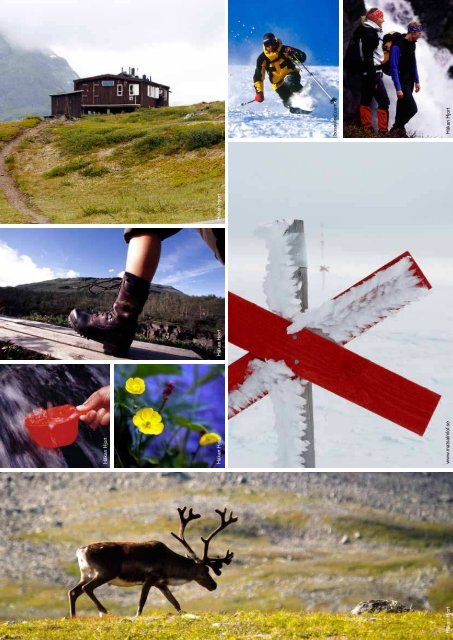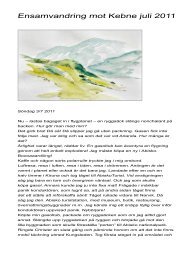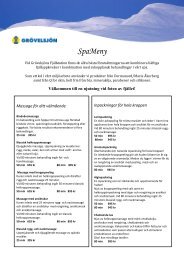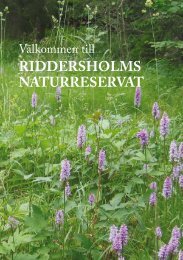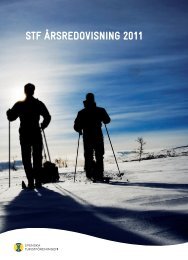THE KING'S TRAIL (KUNGSLEDEN) - Svenska Turistföreningen
THE KING'S TRAIL (KUNGSLEDEN) - Svenska Turistföreningen
THE KING'S TRAIL (KUNGSLEDEN) - Svenska Turistföreningen
Create successful ePaper yourself
Turn your PDF publications into a flip-book with our unique Google optimized e-Paper software.
Håkan Hjort<br />
Håkan Hjort<br />
Håkan Hjort<br />
Håkan Hjort<br />
bosselind.com<br />
Håkan Hjort www.matsalmlof.se<br />
Håkan Hjort<br />
The eight faces of paradise<br />
It’s been occasionally referred to as<br />
Europe’s last wilderness, the mountain<br />
range stretching from Lapland down<br />
to Dalarna. If anything deserves to be<br />
called Sweden’s own paradise, it is this<br />
majestic mountain world. New views<br />
and natural experiences are constantly<br />
emerging here. Large areas are protected<br />
and have been designated as nature<br />
reserves, national parks, and even world<br />
heritage sites.<br />
Life in Lapland has many faces.<br />
The Sámi people, who have lived and<br />
worked here for thousands of years,<br />
estimate that there are eight seasons<br />
up here.<br />
Lapland – another country within<br />
Sweden’s borders<br />
Sweden has 11 peaks over 2,000 metres.<br />
And you will find all in Lapland.<br />
There is even a series of the country’s<br />
most spectacular valleys here. Together,<br />
they form an exceptional, varying<br />
nature with everything from lush<br />
mountain forests down in the valleys<br />
to almost barren environments and<br />
glaciers up on the bare mountain<br />
region. In the summer, the mountain<br />
valleys can be pure jungles in spots,<br />
with both alpine blue sow-thistle and<br />
angelica as tall as a person. Trailing<br />
azalea, alpine gentian, moss campion<br />
and mountain avens are happy on the<br />
mountain moors. Higher up on the<br />
bare mountain region, you can be<br />
lucky to see the glacier crowfoot, the<br />
number one survivor of Swedish flora.<br />
The UN organization, UNESCO,<br />
has elevated part of Lapland to the<br />
status of World Heritage Site under<br />
the name Laponia, where the national<br />
parks Stora Sjöfallet, Padjelanta, Sarek<br />
Thanks to STF and the King’s Trail<br />
(Kungsleden) the innermost part of<br />
Lapland has been available to everyone<br />
for over one hundred years.<br />
To make it easier, we have chosen two<br />
periods for you, when summer and<br />
winter along the King’s Trail are the<br />
absolute best: from June to September<br />
and from February to April.<br />
During the summer season, the<br />
mountain nature of colours, scents,<br />
sounds and movement vibrate. It is<br />
essentially daylight all day and north<br />
of the Arctic Circle, the midnight sun<br />
shines brightly for several months. In<br />
September, the autumn colours are a<br />
and Muddus, the nature reserves Sjauna<br />
and Stubba, parts of Kvikkjokk-Kabla,<br />
and Sulitelma and the Rapadalen<br />
Valley delta are included.<br />
<strong>THE</strong> BIG FOUR<br />
Just like the paradise described in<br />
poetry, Lapland is a sanctuary for wild-<br />
life. For those who know what to look<br />
for, you can find tracks from the big<br />
four of Swedish fauna – lynx, wolverine,<br />
bear and possibly wolf. Perhaps<br />
even see one of them up close.<br />
Up here, you also have the chance<br />
to view golden eagle, gyrfalcon,<br />
peregrine falcon, long-tailed skua,<br />
ptarmigan, eurasian golden plover,<br />
bluethroat, snow bunting and many<br />
other birds. Approximately half of<br />
the country’s 400 bird species have<br />
been sighted in Lapland.<br />
Another common sight is the king<br />
of Swedish nature, elk, not the least in<br />
the Tarradalen and Rapadalen Valleys.<br />
blaze. You can travel by foot on well-<br />
worn trails, sometimes with a break<br />
for a boat ride over a mountain lake.<br />
Skis apply if you choose the winter<br />
season. In February and most of March,<br />
the snow temperatures are cold for ski<br />
waxing and the days quickly become<br />
longer and brighter. Late winter –<br />
early spring brings crusty snow and<br />
long, sunny days.<br />
Let us at STF take you to this<br />
paradise. By foot or on skis. We<br />
promise that you’ll take part in many<br />
exciting and inspirational encounters.<br />
Regardless of which season you choose.<br />
Of course, wildlife takes it easy during<br />
the winter, but some species change<br />
over to their white winter colours and<br />
work as usual. Arctic fox, hare and<br />
ptarmigan are some examples. It is not<br />
uncommon for skiers to see wolverine<br />
and lynx tracks.<br />
GET TO KNOW SÁMI LIFE<br />
Reindeer breeding and the Sámi culture<br />
are very much alive along the King’s<br />
Trail. During the summer in particular,<br />
you can meet the Sámi people<br />
and their reindeer in the mountains.<br />
Avoid disturbing grazing reindeer and<br />
please keep dogs leashed. If you<br />
would like to know more about Sámi<br />
history, language, culture and today’s<br />
reindeer breeding, we recommend<br />
that you visit the Swedish mountain<br />
and Sámi museum Ajtte in Jokkmokk.<br />
You can also visit www.samer.se


